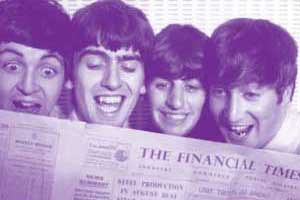Exhibit presents a snapshot of a single topic with a collection of stats, trivia, and factual found objects. This time‘s theme: advertising.
Worldwide product placement in all media was worth $3.5 billion in 2004, a 200% increase from 1994.
In 2005, there were 108,000 instances of product placement in television programming—up 30% from 2004.
Due to TiVo and other ad-skipping digital video recorders (DVRs), TV networks could lose up to 10% of their ad sales by next year.
The ceo of Turner Broadcasting told Cable World that using DVRs to fast-forward through ads is “actually stealing the programming.” But, he conceded, “[t]here’s a certain amount of tolerance for going to the bathroom.”
The 2005 season of nbc‘s reality show The Contender had 7,502 instances of product placement—adding up to 11 hours and 57 minutes of screen time.
1,000 Pontiac Solstices were sold in under an hour following an April 2005 episode of The Apprentice featuring the car.
Last fall, cbs carved the name of its new program Jericho into a Kansas cornfield.
CBS also hired EggFusion, an “on-egg messaging” company, to print its logo on 35 million eggs.
During the first 4 months of 2006, TV shows mentioned or showed Apple products at least 250 times. In early episodes of 24, the good guys used Macs, the bad guys PCs.
8 out of 10 American movie screens now display ads before films. Revenues from these ads increased 103% from 2002 to 2005.
Placing ads inside video games is expected to be a $1 billion industry by 2010. One-third of revenues will come from “advergaming” such as Sneak King, an Xbox game created by Burger King.
Advertisers spend more than $12 billion a year marketing to kids. The average American child is exposed to 40,000 ads per year.
When Dateline NBC recently asked children to choose between a banana and a rock with a Scooby-Doo sticker on it for breakfast, nearly all chose the rock.
Disney sells its own brand of fruits and vegetables stickered with its characters.
In 2003, Hasbro introduced the Play-Doh McDonald’s Restaurant Playset (with which kids can “extrude Play-Doh shakes and fries”) and the Play-Doh George Foreman Grill.
Monopoly now features playing pieces molded in the image of McDonald’s french fries, a Toyota Prius, a Motorola cell phone, and a Starbucks mug.
M&M’s sells books—in regular and peanut—designed to teach babies and preschoolers how to count using its candies.
Nike logos and General Motors cars were drawn into recent DC and Marvel comics. DC says its superheroes will start pushing “a lot more health and beauty care” products.
References to “a killer coat of Lipslicks” and other Cover Girl products were worked into Cathy’s Book, a novel for 12- to 17-year-old girls published in October.
Last year, Clear Channel radio started airing 1-second ad spots called “blinks.”
Safeway, Walgreens, and other retailers are using hypersonic sound technology to beam messages audible only to individual shoppers as they pass by particular products.
Between October 2002 and March 2005, the Bush administration spent $1.6 billion on public relations and advertising. That’s more than 10 times what the Clinton administration spent in its second term.
Announcing Rumsfeld’s resignation, Bush said, “It’s tough in a time of war, when people see carnage on their Dell television screens.” Dell’s chairman is a major gop donor.
After Israel bombed Lebanon last summer, Johnnie Walker put up billboards in Beirut showing a damaged bridge with the slogan “Keep Walking.” A spokeswoman said the ads were meant to “capture a popular mood about moving forward.”
A recent Broadway production of Sweet Charity was rewritten to plug Gran Centenario tequila. José Cuervo described the change as “elegant, organic, not forced.”
In Instant Def, an online movie made by Snickers, members of the Black Eyed Peas work in a Snickers factory and battle an evil rapper who is a “fabrication justification of some corporation’s imagination.”
In the top 20 songs of 2005, Mercedes-Benz was mentioned 100 times, Nike 63, Cadillac 62, Bentley 51, and Rolls-Royce 46.
Last June, the Anheuser-Busch-sponsored World Cup forced hundreds of Dutch fans in orange lederhosen emblazoned with another brewery’s logo to watch a match in their underwear. The world soccer body called the stunt “a mass ambush publicity campaign.”
A blog about a french fry that looked like Abraham Lincoln was exposed in early 2005 as a McDonald’s-sponsored “flog”—one of a new wave of promotional websites designed to appear like blogs written by happy consumers. (See “For Love or Money”)
In 2002, Sony Ericsson sent 60 actors to New York and Seattle to ask bystanders to take their picture with a new camera phone and then tout its features.
In November 2005, Sony hired graffiti artists to spray-paint PlayStation ads on walls in Los Angeles, Miami, and 5 other cities.
In 2001, San Francisco fined ibm $120,000 for spray-painting city sidewalks. The next year, Microsoft was fined $1,050 for sticking decals on New York sidewalks.
A Queens couple funded their $80,000 wedding last summer with plugs such as including coupons in their programs and tossing 25 bouquets from 1-800-FLOWERS.
In September, designer Marc Jacobs allowed his Manhattan shop to be used as a set for a porn movie, provided his logo was visible in the scene.
Wizmark’s “Interactive Urinal Communicator” plays 10-second promotional messages to the “ever elusive targeted male audience you are constantly aiming for.”
US Airways makes $10 million a year selling ad space on tray tables and napkins, and is negotiating selling ads on its airsickness bags.
Great Moments in Product Placement
23 B.C. Roman poet Horace writes odes to specific wines, possibly due to pressure from winemakers.
1896 Lever’s Sunlight Soap appears in early motion pictures.
1965 A Charlie Brown Christmas is conceptualized and sponsored by Coke.
1982 Reese’s Pieces sales blast off by 65% after E.T. munches on them.
1983 Brown & Williamson pays Sylvester Stallone $500,000 to smoke its cigarettes in his movies.
1986 After Top Gun is released, the Navy gets a one-time boost of 7,300 extra aviation recruits.
1993 Space Marketing Inc. proposes launching a mile-wide “space billboard” visible from earth.
1994 Ford Bronco sales rise 25% after O.J. Simpson’s slow-speed chase.
1998 Two Georgia teens are suspended for wearing Pepsi T-shirts to their high school’s “Coke Day.”
2000 FedEx says of its supporting role in Castaway, “We’re a character in this movie.”
2003 Samsung puts a record $100 million into The Matrix Reloaded, which features its cell phones.
2005 Target buys all ad space in the August 22 New Yorker; its logo appears more than 1,200 times in the issue.
See sources <a href=”/news/exhibit/2007/01/exhibit_sources.html” target=”new”>here</a>.













